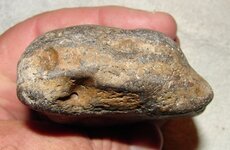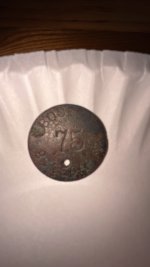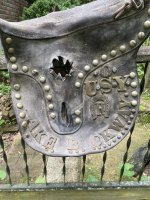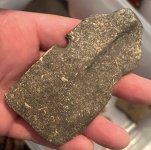Southern_Digger
Hero Member
- May 21, 2012
- 573
- 222
- Detector(s) used
- Minelab Explorer and Excalibur; Tesoro Tejon; Fisher 1265-X; Garrett Master Hunter; White's Coinmaster; In closet: Bounty Hunter and Relco
- Primary Interest:
- Other
Generally, I don't care to use the SW forum for posting finds not made in the water, however, I believe someone reads this who has lease rights and have been salvaging their this past summer. If so, they may be able to i.d. my suspicions. So, first, my apologies for posting here... but...
I searched the beach after the NE'er this past week and made a non-exciting, but unusual find. I learned while out there, that, during this past season, that holes were being punched by salvors in the surf at the 1618 wreck site; and, not too far off the beach. A short distance south of the big pines, I found a rock on the beach that appears non-natural to Florida geology; and, may be a ballast stone. Of course, it may have also come from the renourished (aka, destruction of Florida's natural beauty) beach. However, the stone has unusual imprints, or holes bored into it. Not sure if this is natural and caused by sealife; or, if it is man-made. Anyone's opinion on this is certainly welcome.
a) Size of rock: 3 3/4" long; slightly under 3" width; 1 1/4" thick at its thickest point.
b) Surface appears smooth and it appears to be a type of granite.
c) Photos:
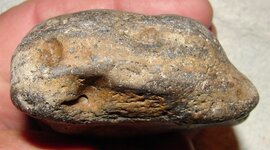
End of rock
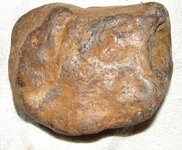
bottom
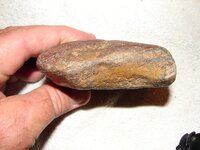
side example
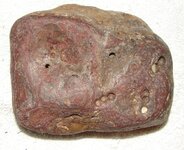
top: Upper left is concave and has one perfectly-round hole bored into it. Right side of stone has four groups of similar holes, all shallow in depth. As photo depicts on right side: Lower-left are 3-holes in a row; above that is a single hole; upper-right has two diagonal holes-a small pc. of shell in one hole; And last, on the lower right are 3-holes, a pc. of shell in the lower one. It has perplexed me...
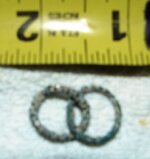
Also found south of the big pines, this small link of copper, or brass chain--rather thin and may not be a period artfact.
Thank You,
SD
I searched the beach after the NE'er this past week and made a non-exciting, but unusual find. I learned while out there, that, during this past season, that holes were being punched by salvors in the surf at the 1618 wreck site; and, not too far off the beach. A short distance south of the big pines, I found a rock on the beach that appears non-natural to Florida geology; and, may be a ballast stone. Of course, it may have also come from the renourished (aka, destruction of Florida's natural beauty) beach. However, the stone has unusual imprints, or holes bored into it. Not sure if this is natural and caused by sealife; or, if it is man-made. Anyone's opinion on this is certainly welcome.
a) Size of rock: 3 3/4" long; slightly under 3" width; 1 1/4" thick at its thickest point.
b) Surface appears smooth and it appears to be a type of granite.
c) Photos:

End of rock

bottom

side example

top: Upper left is concave and has one perfectly-round hole bored into it. Right side of stone has four groups of similar holes, all shallow in depth. As photo depicts on right side: Lower-left are 3-holes in a row; above that is a single hole; upper-right has two diagonal holes-a small pc. of shell in one hole; And last, on the lower right are 3-holes, a pc. of shell in the lower one. It has perplexed me...

Also found south of the big pines, this small link of copper, or brass chain--rather thin and may not be a period artfact.
Thank You,
SD
Amazon Forum Fav 👍
Attachments
Last edited:


